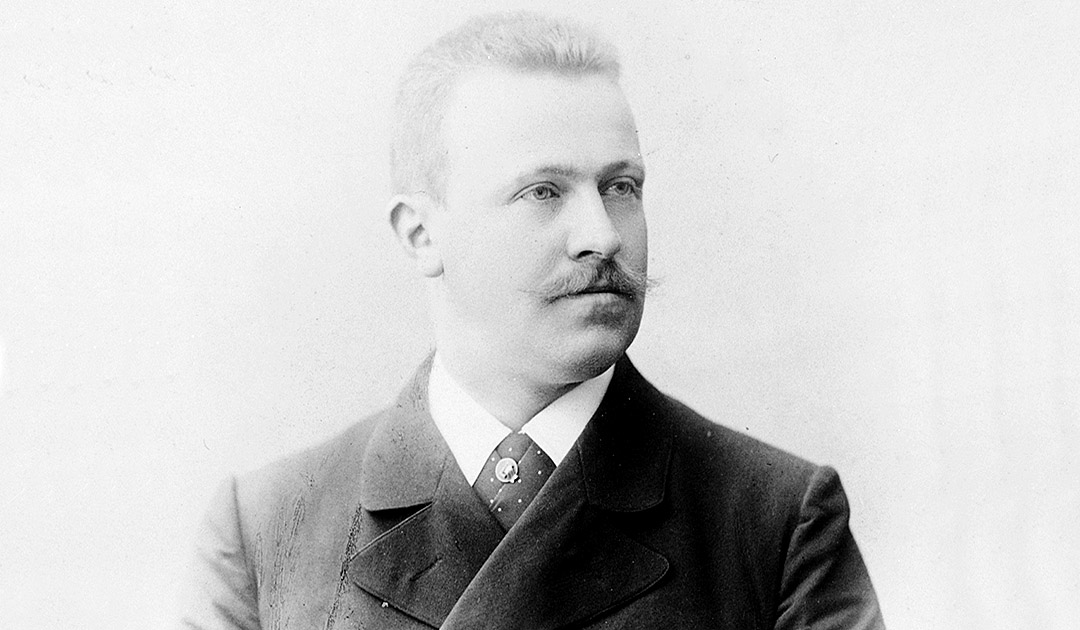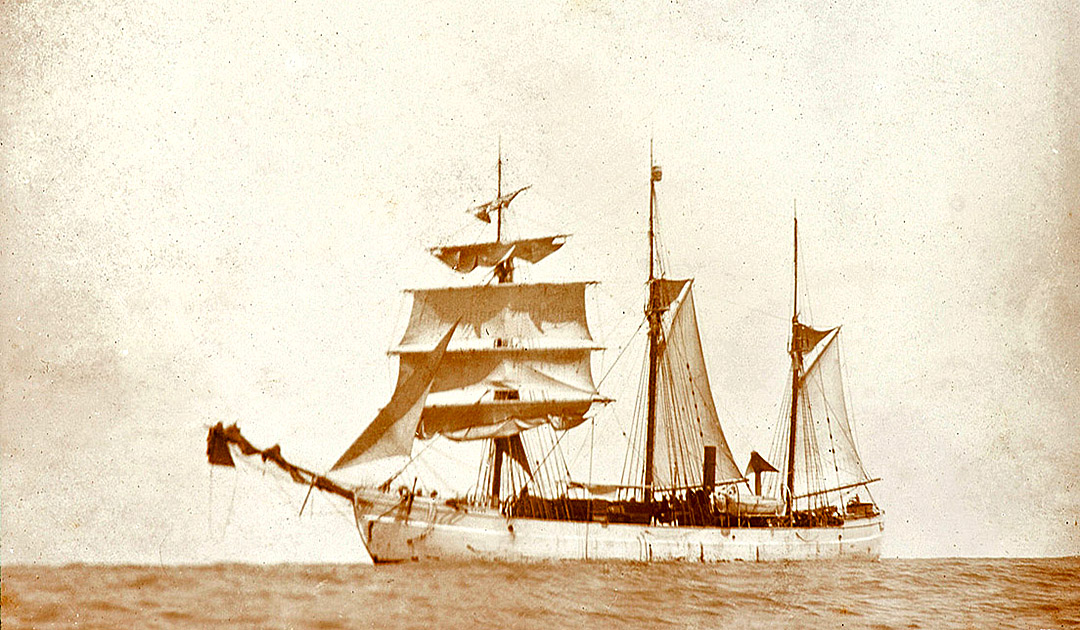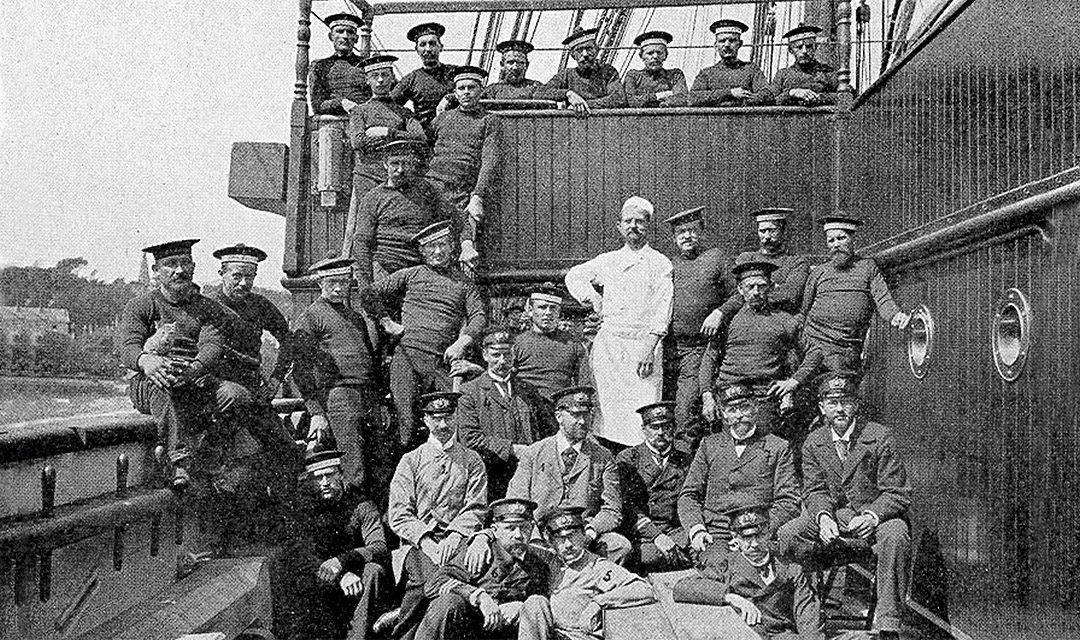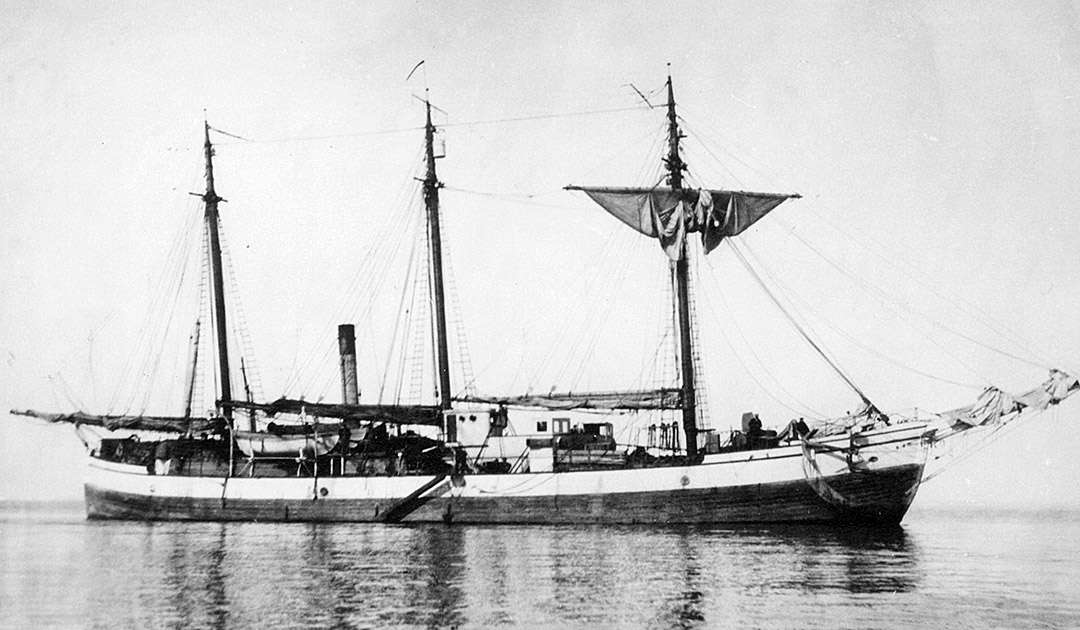
The director of the German Naval Observatory Georg von Neumayer was the initiator of German Arctic research. At the VIII. International Geographers’ Congress in Berlin in October 1899, he was able to present the project of a South Polar expedition. Erich von Drygalski, professor of geography and geophysics at the University of Berlin, was chosen to lead the expedition because he had already gained polar experience during an expedition to Greenland. He showed a good track record of conducting serious scientific studies in polar conditions.

The German Reichstag financially supported the expedition with one and a half million marks. Construction of the expedition ship began in 1900. The ship had cost 500,000 marks, it was 46.3 meters long (152 feet) and 11.2 meters (37 feet) wide. Bow and stern were equipped with steel reinforcements. But the ship’s features were less impressive; it was slow, uncomfortable in rough seas, dark inside, and oppressively hot in the tropics.
The equipment also included a 325 hp auxiliary engine. Sailing, however, was still the main means of propulsion. Each officer and scientist had their own cabin, and there were two dining and lounge areas. A year later, the ship was christened after the founder of scientific Antarctic research, Karl-Friedrich Gauss.

The “Gauss” left Kiel for Antarctica on August 11, 1901. It was to explore the sector between 60° and 90° East, as this was close to the magnetic South Pole and little was known about the area. The “Gauss” reached the Kerguelen Islands in the Indian Ocean on January 2, 1902. On January 31, the “Gauss” left the Kerguelen Islands for Antarctica and seven days later they sighted their first iceberg.
On February 21, 1902, land was first sighted, lined with 40 to 50 meter high ice cliffs. This was titled Kaiser-Wilhelm-II-Land and later renamed Wilhelm-II-Küste. The “Gauss” attempted to sail on, but was trapped by the formation of sea ice. The crew tried to blast a way out with explosives, but to no avail. On March 2, it became clear that the “Gauss” was trapped 74 kilometers (46 miles) from shore for the winter.

Drygalski was first and foremost a scientist. His intention was to find out as much as he could about the sector of Antarctica he was in. He and the scientific members of the crew got ready to observe magnetic, meteorological and astronomical phenomena. Observation posts were set up and holes were drilled through the ice to collect rocks from the seabed.
On March 29, 1902, Drygalski made the first ascent in a hydrogen-filled reconnaissance balloon to an altitude of 1600 feet (490 meters) and sighted a dark elevation in the distance. A few days later Drygalski and some of his men made a reconnaissance trip on sleds to the mountain, which was about 80 km away. During a total 13-day mission, the 371-meter-high volcano was explored and surveyed. They named it – like the expedition’s research ship – after the mathematician Carl Friedrich Gauss, or Gauss Berg.

Gauss Mountain turned out to be the southernmost point reached by the expedition. More sledding trips there were made in April before winter fully set in. Drygalski climbed to the top of Gauss Mountain on the last trip and described a landscape composed entirely of ice except for the rocky outcrop of Gauss Mountain itself.
Winter came and the men kept themselves busy as best they could. The ship was well supplied and there was plenty of private and public space. Lectures were arranged and clubs were formed, a music club, a smoking club, card clubs and a midwinter festival were organized. Although the men found that winter had its hardships and became depressed due to the lack of daylight and the cold and storms outside that often confined them to the ship, they survived as well as any other contemporary winter voyagers.
Drygalski had hoped to reach 72 ° or 73 ° S, but circumstances in the spring of 1903 led to the abandonment of this idea. He thought there was no good scientific reason to go further south. He had read about the circumstances of the crew of the “Belgica” and the difficulties it had in escaping the ice. While the “Belgica” was locked in an ice thickness of about 7 feet (2 m), the Gauss was in an ice thickness of 16 to 19 feet (5 to 6 m), and beyond that there were snow drifts of up to 40 feet (12 m).

The release seemed closer and closer at the beginning of the year, but on January 21, 1903, a violent storm closed the channel and drove snow across the open water as if it had never been there. A week later, on January 28, the entire area was on the move and Drygalski ordered all equipment off the ice and back on board. The Gauss was now drifting with the ice, although still trapped in it.
It became warmer and seals and birds were again sighted in large numbers. The ice began to break up, but the ship was still about 2000 feet (600 m) from open water. Explosives and long ice saws were used to try to cut a channel to the open water, but to no avail. The crew then scattered ash several times in the area between the “Gauss” and the ice edge. The sun’s rays melted a channel two meters deep into the ice beneath the dark, heat-absorbing layer of ash.

On February 8, Drygalski wrote, “We suddenly felt two sharp jolts in quick succession … it was like a revelation, and with a cry of ‘The ice is breaking,’ I jumped onto the deck.” The “Gauss” got free and reached open water again on March 16.
The ship sailed again to the Kerguelen Islands and then continued on to Cape Town, South Africa, where it docked on June 9, 1903. From there Drygalski sent a request to Berlin to spend another winter in Antarctica. His request was denied, most likely because the emperor was disappointed that no significant new territory had been discovered nor sensational adventure reported. The “Gauss” set off north again on November 23, 1903, and reached Kiel. It was sold to Canada to pay for the expedition.

What did the expedition gain
As a scientific expedition, it had been a great success, and the achievements were highly praised by the scientific community. Twenty volumes of reports were published from 1905 to 1931. The expedition provided strong evidence for the existence of the Antarctic Convergence, six hundred miles of coastline were surveyed, and 1,440 species of living organisms endemic to Antarctica were described.
As a public interest expedition, however, it was far overshadowed by others that had reached higher latitudes (closer to the pole) at about the same time. What was not appreciated by the public was that the “Gauss” was in a completely new region that nobody had ever visited before, where it worked alone and published completely new discoveries. Compared to more sensational adventures, however, the layman sees one or ten new species of obscure fauna or carefully described scientific observations as of little value.
Heiner Kubny, PolarJournal





